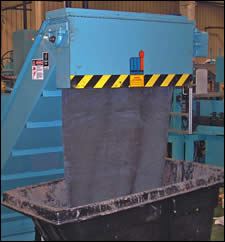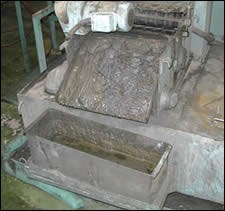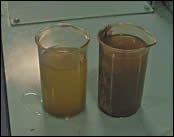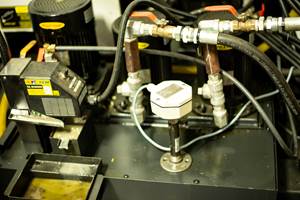Coolant Filtering System Delivers A Clutch Performance
Sludge and grit in contaminated coolant can build up in the moving parts of machine tools and increase component wear, adversely impacting productivity. Faced with rising maintenance costs and increased machine downtime, this manufacturer of automotive components found a solution in a coolant cleaning system developed by Mayfran International.
Share









Takumi USA
Featured Content
View More
ECi Software Solutions, Inc.
Featured Content
View More
Hwacheon Machinery America, Inc.
Featured Content
View More.png;maxWidth=45)
DMG MORI - Cincinnati
Featured Content
View MoreCoolant that is contaminated with sludge and grit can adversely affect any shop’s operations. Shutting down machines to clean tanks can cut hours from valuable production time. When faced with this problem, an Indiana-based automotive manufacturer invested in a coolant cleaning system that has reduced machine downtime, freed valuable floor space and cut maintenance and servicing costs.
FCC (Indiana) Mfg. is a subsidiary of FCC Co., a worldwide producer of automatic and manual transmission clutch housings, torque converter components, CVT starting clutches and four-wheel-drive clutches for automakers. Facing challenges from global competition and ever-demanding customers, the firm and its parent company continually investigate and implement improvements to operations and processes. The goal is to optimize just-in-time delivery schedules, enhance part and component quality and advance ergonomic issues and efficiency throughout the enterprise.
Such was the case when FCC began a review of its manufacturing process for clutch plates at its facility in Portland, Indiana. First, the plates are stamped from a mild steel plate. They are then deburred to knock off sharp edges and sanded on both sides with a complex system resembling a large belt sander. According to Gabe Dann, a senior staff engineer, the sanding process results in three distinct outcomes.
“First, we achieve the necessary plate thickness, held to a very tight tolerance,” Mr. Dann says. “Second, the sanding provides the required surface finish for each side of the plates. The third outcome is that the process produces a large amount of sanding sludge.” This sludge, a mixture of metal dust from the plates and grit from the sanding belt, permeates the entire process. If not properly filtered from the coolant, it can affect both quality and productivity.
The shop had a cleaning process in place, but it was far from adequate. Its eight sanding machines are each equipped with their own magnetic separators and coolant holding tanks. After the contaminated coolant passed over the magnetic surface, the so-called “clean” liquid was recycled back into the process. The sludge on the magnetic separator was scraped off and conveyed out to a separate holding container.
However, this process left so much sludge in the “clean” tank that each machine had to be shut down twice a week for two hours to clean the tank and associated equipment. Additionally, the floor space around the machines required constant cleaning because of spillage and overflows. “Four hours per week per machine of lost production, plus the additional labor hours for cleaning, was unacceptable,” Mr. Dann says. “Then, too, were the additional costs.”
These additional costs included using 48 gallons of coolant formula and more than 2,800 gallons of water per week, along with the environmentally controlled disposal of 2,400 gallons of contaminated wastewater per week. Cleaning the machines cost nearly $9,000 per year in labor, while properly disposing of wastewater cost more than $112,000 per year. “There had to be a better way,” Mr. Dann says.
He found the solution at the International Manufacturing Technology Show (IMTS) in 2006. At the show, Mayfran International, a manufacturer of conveyor, filtration and separator units, introduced its VacuFilter coolant cleaning system. The device can be used with virtually all types of cutting fluids and lubricants. In addition to sanding, which requires filtration of fine particulate from coolant, the system is especially suited for applications such as grinding, honing, lapping, polishing, gun drilling and parts washing, the company says. The compact system can be installed either on the floor or in a pit below the floor and can work with multiple machine tools. FCC has situated each filter unit on the floor between the two sanding machines it services.
The unit draws contaminated fluids through a disposable paper filter media that is supported by a septum plate to capture the solids. A conveyor pulls and elevates this media, along with the netted sludge and particulate, to a discharge area for disposal. Indexing of the media is actuated automatically via a sensor that monitors the vacuum created by the pump. The pressure differential between the clean coolant side and the contaminated side increases as particulate builds up on the filter media. When this particulate reaches a predetermined level, a signal sent to the control unit indicates an index. During an index cycle, coolant flow to the sanding machines is not interrupted.
The VacuFilter’s design uses a single pump to provide for fewer parts, reduced maintenance, durability and long service life. The media is selected based on application parameters such as fluid type, workpiece materials and process/particulate form. Unlike the shop’s previous magnetic separator units, the device filters virtually all particulates from the coolant, including nonferrous grit.
Since installing the system, FCC has significantly reduced both the cleaning time and downtime previously required for its sanding operation. Now, the shop spends about two hours every three months cleaning the Mayfran units, and the sanding systems require virtually no cleaning, Mr. Dann says. This was quite an improvement over the previous system, which required shutting down the machines for two hours every week.
Also, handling and disposal is easier because most of the sludge adheres to the paper filter media. Operators place the spent filter material in a sealed drum and dispatch it for proper disposal, making the task of cleaning the machines a much more pleasant job than the previous process. The surrounding floor space is cleaner and safer, with virtually no spillover and less manual handling of the sludge.
In addition to labor and time savings, Mr. Dann reports that the VacuFilter systems have reduced both water usage and wastewater production by as much as 80 percent. The shop has seen a similar reduction in disposal costs. Eliminating the buildup of sludge on the surface and within the grit of the sanding belt has increased service life, and the amount of coolant chemicals used has also been slashed by approximately 80 percent. Mr. Dann says he also expects maintenance and service cost reductions over the long run because sludge and grit in the coolant no longer works its way into the moving parts of the machines. Additionally, these benefits enabled the shop to eliminate one of the holding tanks previously used to store contaminated wastewater, freeing up valuable floor space.
“The Mayfran VacuFilters have helped us reach a level of continuous improvement in our productivity, our quality output, and, we’re proud to say, in an environmentally responsive process,” Mr. Dann says.
Related Content
Fortech Synthetic Coolant Enables Bio-Stable Metal Removal
Fortech’s TechKool FT4000 synthetic coolant is formulated to reject tramp oil that can cause smoking or misting and premature spoilage of coolant.
Read MoreConsiderations for Machining Coolant Care
Coolant care can be simply managed if you know where to pay attention and which hazards to look out for.
Read MoreManaging Coolant with Skimmers, Refractometers and More
Bacteria-infected coolant harms machines and sickens machinists. Coolant management technologies like skimmers and automated systems counter this tendency.
Read MoreJorgensen's Coolant Collection System Eliminates Sludge Build-Up
The PermaClean system adds agitation to the coolant collection system or holding tank and prevents particulates from settling.
Read MoreRead Next
Building Out a Foundation for Student Machinists
Autodesk and Haas have teamed up to produce an introductory course for students that covers the basics of CAD, CAM and CNC while providing them with a portfolio part.
Read MoreRegistration Now Open for the Precision Machining Technology Show (PMTS) 2025
The precision machining industry’s premier event returns to Cleveland, OH, April 1-3.
Read More5 Rules of Thumb for Buying CNC Machine Tools
Use these tips to carefully plan your machine tool purchases and to avoid regretting your decision later.
Read More































.jpg;maxWidth=300;quality=90)










.jpg;maxWidth=300;quality=90)







